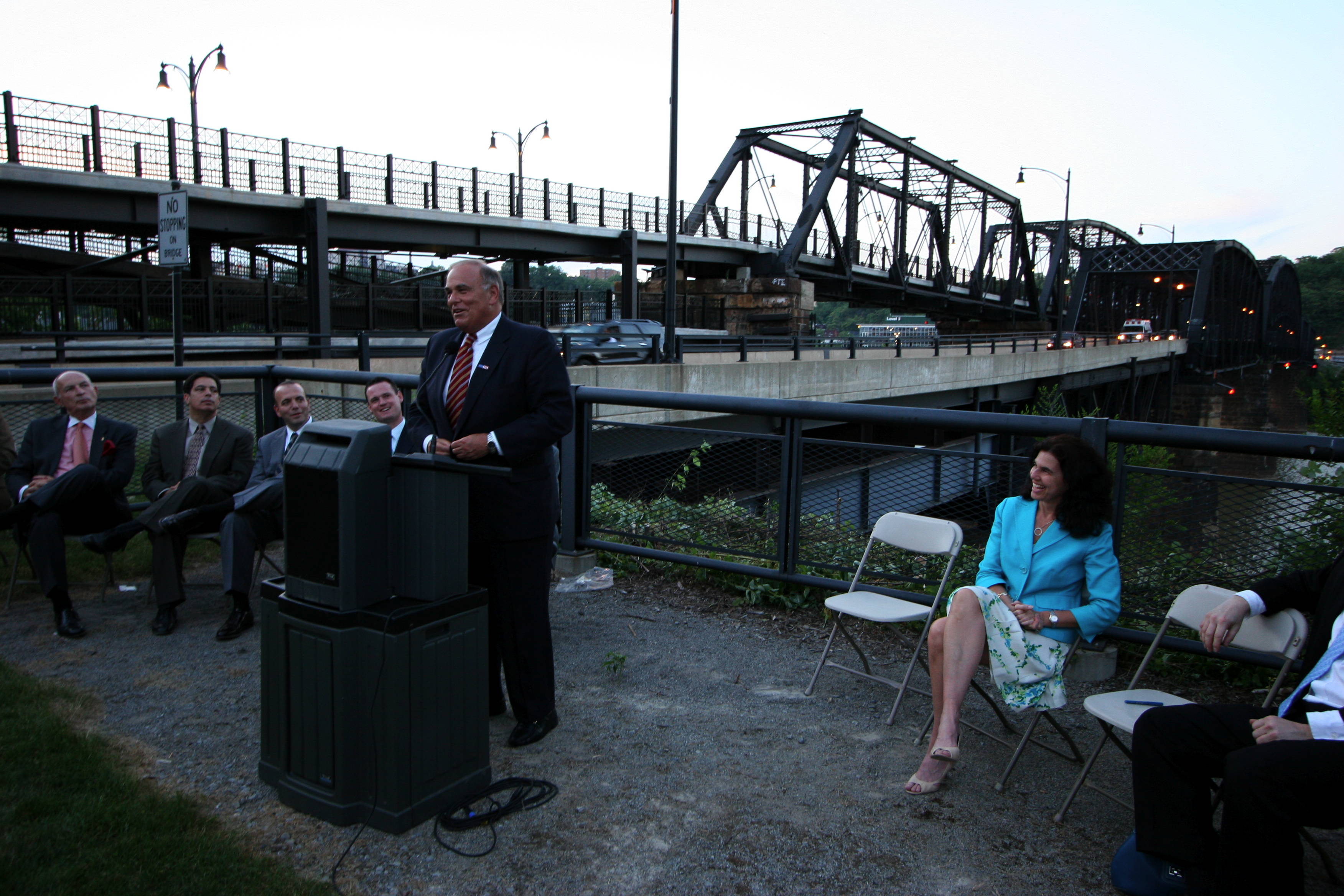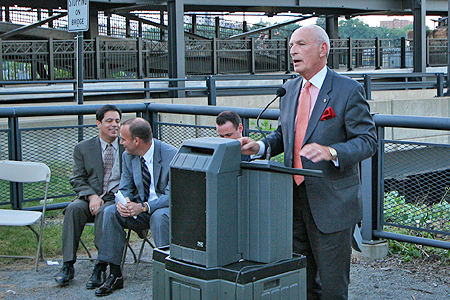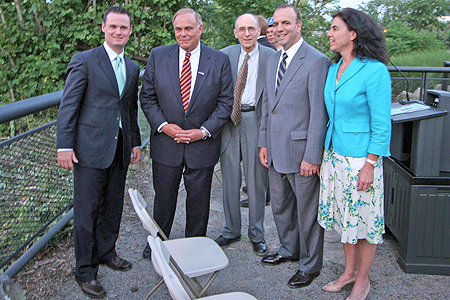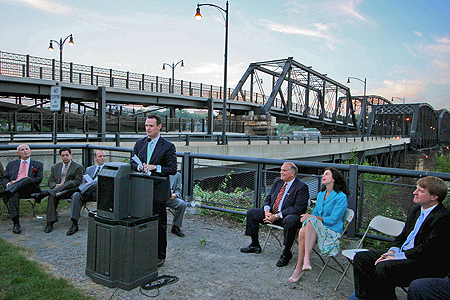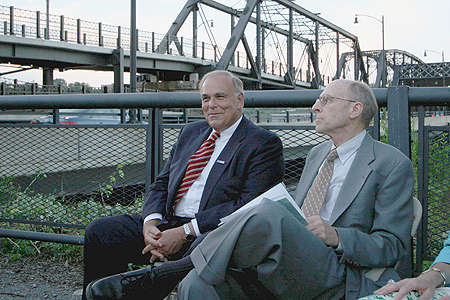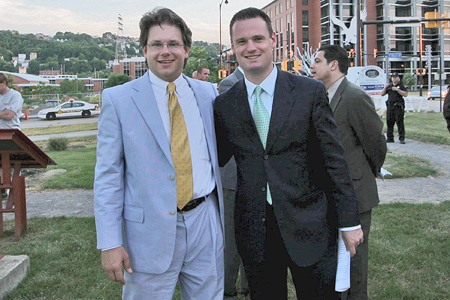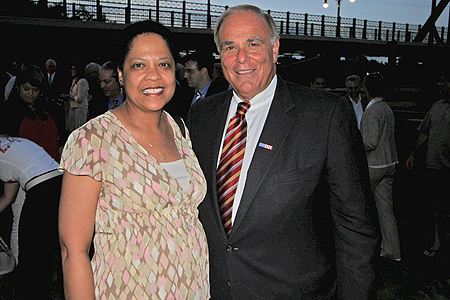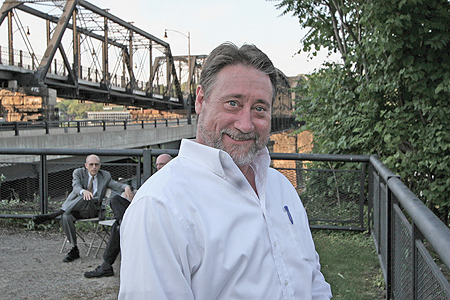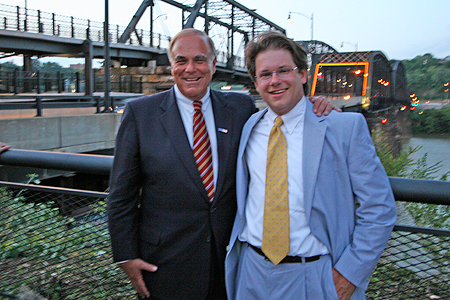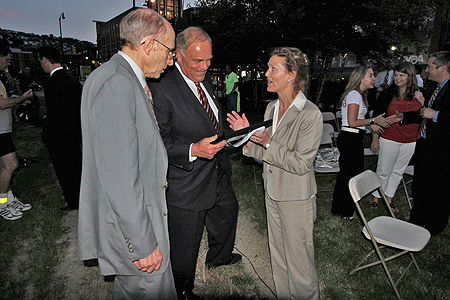
Category Archive: Preservation News
-
Dramatic redesign approved for Market Square
Wednesday, July 02, 2008The city of Pittsburgh’s Historic Review Commission today approved a dramatic redesign of Downtown’s Market Square, clearing the way for construction planning but urging that the architects meet with Pittsburgh History & Landmarks Foundation officials about their concerns.
The redesign would allow car traffic around the outside of the square, but not in the streets that run through its center. It would replace the network of streets, curbs, and raised tree planters with a flat piazza, where driving, parking, dining and walking would be demarcated by different paving materials.
Closed to cars would be Graeme Way and McMasters Way, which link the square to Fifth Avenue.
“We’re trying to give Market Square back to the pedestrians,” said Pittsburgh Downtown Partnership President Mike Edwards, whose group is leading the charge on the $5 million reworking of the square. “Right now, it’s a thoroughfare. We want it to be a destination.”
Pittsburgh History & Landmarks Foundation is concerned that the closure of Graeme Way to vehicles may crimp access to four buildings that it is renovating at a cost of $3.5 million, said Anne E. Nelson, the foundation’s attorney. The entrances to the second- and third-floor apartments will be off of Graeme Way, she said.
“If people want to drop other people off, or unload things to their apartments, they can’t get there,” Ms. Nelson said.
The commission placed one condition on its approval: that architect Dina Klavon meet with Pittsburgh History & Landmarks Foundation to work through its concerns. Ms. Klavon will bring more detailed drawings back to the commission for a final approval. Construction could start in the spring.
Overall, Historic Review Commission members gushed.
“This will be a miniature Parisian square,” said commission Vice Chairman Paul Tellers.
“The elegance will be the ‘wow’ factor,” said commission Chairman Michael Stern.
More details in tomorrow’s Pittsburgh Post-Gazette.First published on July 2, 2008 at 4:33 pm -
Market Square’s makeover shifts into high gear this week
Monday, June 30, 2008Market Square’s transition is in full swing.
Dunkin Donuts opens there at 6 a.m. today. Moe’s Southwest Grill will open Thursday. A dark, romantic bar is to follow later this summer.
In addition, a veteran restaurant, Buon Giorno, is dressing up for a higher profile. Renovations are ongoing to add a second-story deck that has passed the city’s historic review. And the former Mick McGuire’s will become a wine, cheese and dessert bar called Sante — with an accent on the “e” — later this summer beside the 1902 Landmark Tavern.
Of Sante, Mike Edwards, president and chief executive officer of the Pittsburgh Downtown Partnership, said, “It is supposed to be very romantic. So dark you have to be close” to see each other.
Dunkin Donuts brings another choice of coffee and baked goods within a stone’s throw of Nicholas Coffee, Crazy Mocha, Bruegger’s Bagel Bakery and Starbucks.
When questioned about a possible glut of caffeine choices, Robin Frederick, vice president of marketing and human resources for Dunkin Donuts, said Market Square was an attractive site for the company’s expansion.
“We’re going to do what we do best and hope they do too,” she said of the competitors.
Mr. Edwards said Market Square’s renovation plans have generated “a lot of public buy-in and set a direction for investors to make confident decisions.” He said the years of debate over the Fifth and Forbes make-over stagnated Market Square’s.
“Now we have direction,” he said, citing a $1 million “Paris-to-Pittsburgh” grant from the Colcom Foundation to match up to $25,000 the cost of any restaurant renovation that opens it to the outside. The Pittsburgh Downtown Partnership is administering the grants, which will enable “use of the city the way it should be used, not just as an office park.”
The Paris-to-Pittsburgh grants target Downtown merchants only, he said, adding that Moe’s Southwest Grill “is probably the best use of it.”
Moe’s co-owner Mike Geiger said the restaurant will open to the outside with three bays of windows, each 15 feet wide, and six retractable awnings. It will be the first Moe’s in the city, with four others in the region.
Buon Giorno and Mixstirs, a casual restaurant that offers a range of smoothies, are also going for the Parisian look, and Mr. Edwards said other restaurants have expressed interest.
True to its name, the square becomes a marketplace every Thursday through Oct. 23, with vendors selling fresh produce, baked goods, salsas and other items, from 10:30 a.m. to 2 p.m.
The Fifth and Market project, in which Pittsburgh History & Landmarks Foundation has invested, is also under way and will include several condominiums.
“There’s a maturing going on in Downtown Pittsburgh,” said Mr. Edwards, citing restaurants that have broadened and elevated diners’ tastes. “All the huge, great wonderful projects are important,” he said, but the smaller ones are the connective tissue that will keep making the city compelling.
Diana Nelson Jones can be reached at djones@post-gazette.com or 412-263-1626.First published on June 30, 2008 at 12:00 am -
Cathedral of Learning trumpets education
By Bill Zlatos
TRIBUNE-REVIEW
Sunday, June 29, 2008The Cathedral of Learning was constructed of Indiana limestone and built with the pennies, nickel and dimes of area schoolchildren.John G. Bowman, then chancellor of the University of Pittsburgh, came up with the idea for a tower in 1921.
“He wanted a tall building because his intention was the children of working men and women of Pittsburgh would see the tower and be inspired to get an education,” said Albert Tannler, historical collections director at the Pittsburgh History & Landmarks Foundation.

But there was the issue of money. The cost of the building was estimated at $10 million to $15 million, a hefty sum in those days.
In 1925, Marcus Aaron, chairman of the city’s board of education, summoned the district’s teachers to start a “Buy a Brick” campaign. The teachers told students to give 10 cents to Pitt and tell the university how they earned it. The children would get a certificate indicating they owned a piece of the building.As a result, 97,000 certificates were issued.Parents also gave. In 1926, Bowman went to a meeting of steelworkers and their families in Carnegie to promote his tower.
“A woman stood up with a baby in her arms and said, ‘We got no money, but we’ll go without meat for a week and give you that money.’ Then a man stood up and said, ‘I’ll wear this suit another year and give you the money,’ ” said Maxine Bruhns, director of Pitt’s Nationality Rooms and Intercultural Exchange Programs, who is working on a DVD, “The Story Behind the Construction of the Cathedral of Learning.”
The cathedral is home to 27 Nationality Rooms, which showcase the culture of the ethnic groups that built Pittsburgh.
The steel skeleton of the building was erected in 1929. After the stock market crashed, the 52-story design was shortened to 40. Still, it was the tallest academic building in the world when it was finished in 1937. It remains the biggest in the United States.
“It was a triumph,” Bruhns said, “symbolizing that those parallel lines going skyward never meet and education never ends.”
Bill Zlatos can be reached at bzlatos@tribweb.com or 412-320-7828.
-
Cathedral of Learning trumpets education
By Bill Zlatos
TRIBUNE-REVIEW
Sunday, June 29, 2008The Cathedral of Learning was constructed of Indiana limestone and built with the pennies, nickel and dimes of area schoolchildren.John G. Bowman, then chancellor of the University of Pittsburgh, came up with the idea for a tower in 1921.“He wanted a tall building because his intention was the children of working men and women of Pittsburgh would see the tower and be inspired to get an education,” said Albert Tannler, historical collections director at the Pittsburgh History & Landmarks Foundation.
But there was the issue of money. The cost of the building was estimated at $10 million to $15 million, a hefty sum in those days.
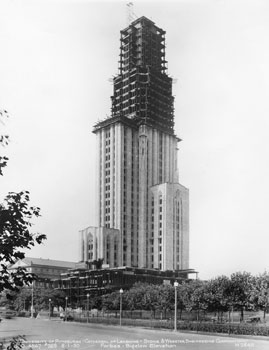
The Cathedral of Learning is home to 27 Nationality Rooms, which showcase the culture of the ethnic groups that built Pittsburgh. The cathedral begins to tower over the city in the summer of 1930. - University of Pittsburgh
In 1925, Marcus Aaron, chairman of the city’s board of education, summoned the district’s teachers to start a “Buy a Brick” campaign. The teachers told students to give 10 cents to Pitt and tell the university how they earned it. The children would get a certificate indicating they owned a piece of the building.As a result, 97,000 certificates were issued.
Parents also gave. In 1926, Bowman went to a meeting of steelworkers and their families in Carnegie to promote his tower.
“A woman stood up with a baby in her arms and said, ‘We got no money, but we’ll go without meat for a week and give you that money.’ Then a man stood up and said, ‘I’ll wear this suit another year and give you the money,’ ” said Maxine Bruhns, director of Pitt’s Nationality Rooms and Intercultural Exchange Programs, who is working on a DVD, “The Story Behind the Construction of the Cathedral of Learning.”
The cathedral is home to 27 Nationality Rooms, which showcase the culture of the ethnic groups that built Pittsburgh.
The steel skeleton of the building was erected in 1929. After the stock market crashed, the 52-story design was shortened to 40. Still, it was the tallest academic building in the world when it was finished in 1937. It remains the biggest in the United States.
“It was a triumph,” Bruhns said, “symbolizing that those parallel lines going skyward never meet and education never ends.”
Bill Zlatos can be reached at bzlatos@tribweb.com or 412-320-7828.
-
Children’s Museum still looking to grow
Thursday, June 26, 2008At 25, the Children’s Museum of Pittsburgh has grown into a mature nonprofit and community leader — although it’s still all about kids.
Originally called the Pittsburgh Children’s Museum, it was on the leading edge of a wave of children’s museums that began opening around the country in the ’80s.
The idea for a children’s museum here dates back to 1972, when a group of community leaders established The Pittsburgh Children’s Museum Project — a mobile traveling museum that started at the Three Rivers Arts Festival.
The physical space opened its doors in the basement of the historic North Side post office building in Allegheny Center in June 1983. The Junior League of Pittsburgh got the project off the ground. Two years later, it expanded to the rest of the building, quadrupling its space and housing an exhibit of puppets from the collection of puppeteer Margo Lovelace.
The ’90s brought other key developments. The Pittsburgh History & Landmarks Foundation deeded the post office building to the museum. The museum launched several educational outreach programs and hosted its first traveling exhibit — “Kidsbridge.” In 1995, another traveling exhibit built around the works of “Sesame Street” creator Jim Henson set attendance records at the museum. In ’98, the museum created a major traveling exhibit of its own: “Mister Rogers’ Neighborhood — A Hands-On Exhibit.” There were two traveling versions of the Rogers exhibit. One is now part of the museum’s permanent collection; the other was donated to the New Orleans Children’s Museum in 2007.
The 21st century also has been a period of ambitious growth. In 2004, the museum expanded again into the former Buhl Planetarium building next door. The museum exceeded its goal in the $28 million capital campaign that funded the expansion, but there were challenges and hurdles, recalls then-board president Anne Lewis, who led the expansion effort and who is now board member emeritus.
“The long-term vision was always to create a community for kids,” Lewis says. “That meant the entire area needed to be brought back with economic development. We knew we had to become the leader and the catalyst for change.”
“The expansion allowed us to do things we’ve always dreamed of doing,” says Children’s Museum executive director Jane Werner.
Increased exhibition space and parking space have raised attendance: This year, the museum set a new attendance record, with a projected 228,000 admissions for the current fiscal year, which ends June 30.
“People are looking at the Children’s Museum as a new model of how to do children’s museums,” Werner says. “It’s been really fun to push those boundaries and try different things. We’ve enjoyed working with artists and taking chances.”
The museum places high priority on designing and building its own exhibits. “In the ’80s, people started to drift away from that and go with outside consultants,” Werner says. “We decided that we really wanted to stay in-house and make sure that our exhibits worked. We’ve gone back to that, and I think people are seeing the value in it.”
Looking ahead to the future, the museum and its neighboring institutions are poised for new growth. The Children’s Museum is in the middle of a $22 million capital campaign to raise the funds to create a green park space in the plaza area in front of the museum, extending the kid- and family-friendly environment outdoors and creating an example of how urban spaces can be green by using bioswales — landscaping elements that use plants to remove pollutants from runoff.
The Children’s Museum is also spearheading the Charm Bracelet Project, an effort to link North Side cultural organizations and create a unified cultural district in that neighborhood.
Lewis is enthusiastic about the museum’s future plans. “You want to bring that experience outside, so that synergy between inside and what’s outside becomes welcoming for kids.”
Adrian McCoy can be reached at amccoy@post-gazette.com or 412-263-1865.First published on June 26, 2008 at 12:00 am -
Public Hearing at City of Pittsburgh Council on the Malta Temple City Historic Structure Nomination
PREPARED TESTIMONY OF
ANNE E. NELSON, ESQ.
GENERAL COUNSEL
PITTSBURGH HISTORY & LANDMARKS FOUNDATION
BEFORE THE PITTSBURGH CITY COUNCIL
PUBLIC HEARING ON THE MALTA TEMPLE
CITY HISTORIC STRUCTURE NOMINATION
June 25, 2008
Pittsburgh History & Landmarks Foundation supports the nomination of the Malta Temple Building to be a city-designated historic structure.
The former meeting house of the Ancient and Illustrious Order of the Knights of Malta is noteworthy for its historical and architectural character. Furthermore, the building’s location, as part of the continuous streetscape of the historic North Avenue next door to the Federal North block, which is also significant. Therefore, the Malta Temple Building should be preserved for the benefit of the residents of Pittsburgh.
The Salvation Army intends to replace the current structure with a building that is almost identical in style and design to the current structure. The reason for the new building is that the existing floor plates do not support the services the Salvation Army needs to offer at that location. Landmarks is currently rehabilitating four historic buildings in Market Square and has altered the floor plates and interiors to meet the new uses of the building. This is done with numerous historic properties.
Landmarks offers its assistance to the Salvation Army in planning to reuse the structure.
-
Point Park University Alumnus Howard B. Slaughter Jr. – Catalyst for Community Growth and Development
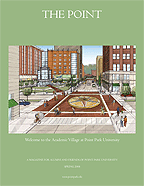 by Colleen C. Derda
by Colleen C. Derda
The Point Magazine, Spring 2008
Point Park UniversityHoward B. Slaughter Jr., D.Sc. (MBA ’01), is enjoying his latest riverfront views. From the offices of Landmarks Community Capital Corp. in Station Square, he can see down the Monongahela River toward Point State Park.
“This office has a great view of Pittsburgh architecture,” says Dr. Slaughter, a man who appreciates old buildings and knows what it takes to restore them. His extensive financing background focuses on economic development and housing developments in urban areas.
Slaughter heads the new Landmarks Community Capital Corp., a wholly owned subsidiary of the Pittsburgh History & Landmarks Foundation, which provides equity, debt and short-and intermediate-term financing for housing and economic development activities throughout Western
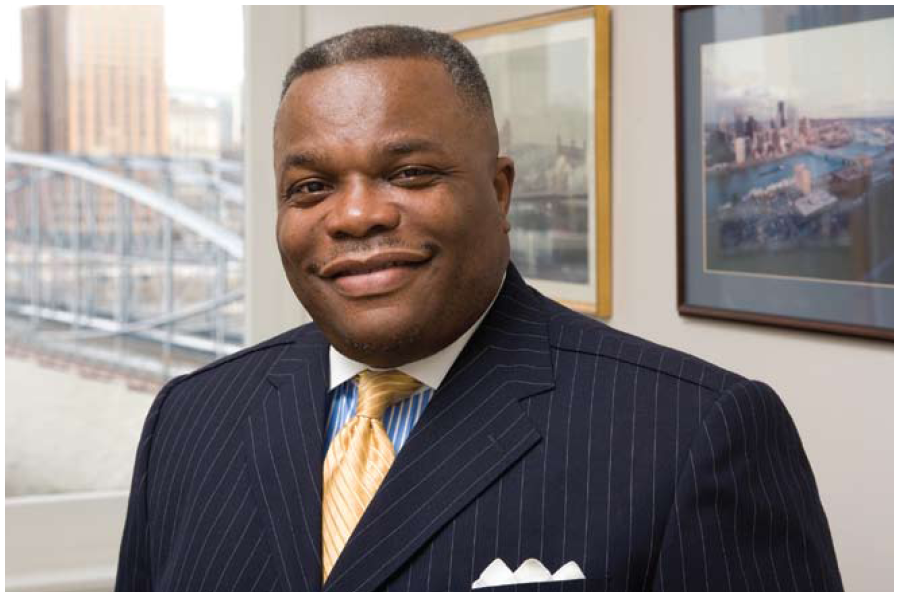
Pennsylvania, West Virginia and Ohio. The nonprofit corporation also aims to pursue public policy initiatives and public-private partnerships as well as utilize such tools as new market tax credits to bring additional capital into the region.
“We have the opportunity to be a catalyst for change,” he says. “Typically we are ‘first in and first out,’ often taking the greatest financial risk, to help move developments forward. We require collateral, but we are a non-traditional lender, with the flexibility to help make revitalization a reality.”
Landmarks Community Capital Corp. recently approved a $885,000 loan leveraging a $7-million revitalization condo development in East Liberty. Working through East Liberty Development Inc., the funding will help transform a former YMCA into condominiums and retail space. Landmarks Community Capital Corp. is also working to attract a supermarket to Pittsburgh’s Hill District, among other unique development projects.
“We have an experienced staff, reflecting ethnic diversity, which helps us to be as effective as possible and to effectuate positive change,” stresses the chief executive officer. “Not only urban neighborhoods, but rural communities can benefit from the corporation’s funding. We work within a 250-mile radius of Pittsburgh.”
Slaughter’s approach to community lending integrates historic preservation as a stimulus for economic development. He previously served as director of preservation services at the Pittsburgh History & Landmarks Foundation before being appointed director of Fannie Mae’s Pittsburgh Community Business Center, the largest source of home financing in the country. His background also includes a stint as a vice president of community development at Dollar Bank, where he led the bank to its first “Outstanding” Community Reinvestment Act rating.
Slaughter was recently appointed treasurer of the Urban League of Greater Pittsburgh and renominated by Gov. Ed Rendell (and unanimously confirmed by the Pennsylvania State Senate) to the Board of the Pennsylvania Housing Finance Agency board. He also serves on the board of the Pennsylvania Community Development Bank. His extensive educational background, which includes five degrees, includes a master of business administration from Point Park.

“I am pleased to have had the opportunity to take advantage of what Point Park offered.
I attended the master’s degree program all day every Saturday for an entire year. It was a commitment, but it enhanced my educational goals and fit my needs well,” says Slaughter, who also holds a master’s degree from Carnegie Mellon University’s H. John Heinz III School of Public Policy and Management and a doctorate in information systems and communication from Robert Morris University.
Slaughter can see a bit of Point Park University from his Station Square office. “I’ve been watching Point Park transform,” he says. “The changes are exciting and a real benefit to the urban core of this region.”
-
Hot Metal Bridge Lighted
PHLF News
June 13, 2008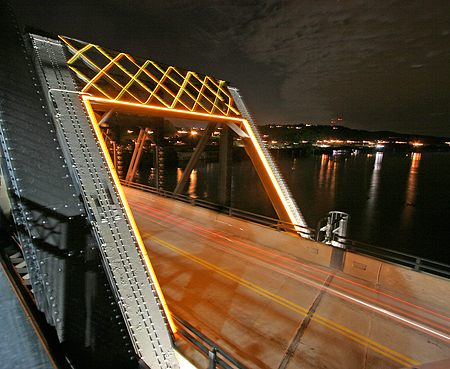
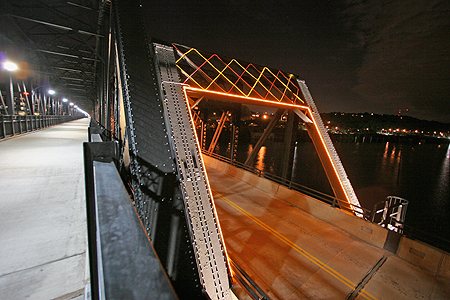
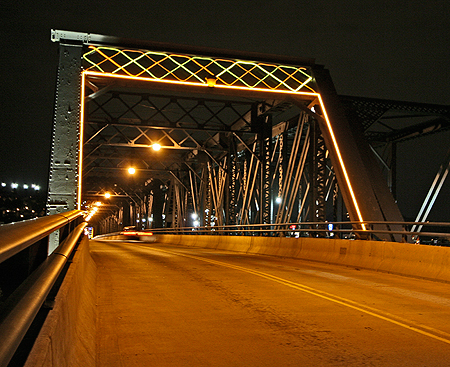
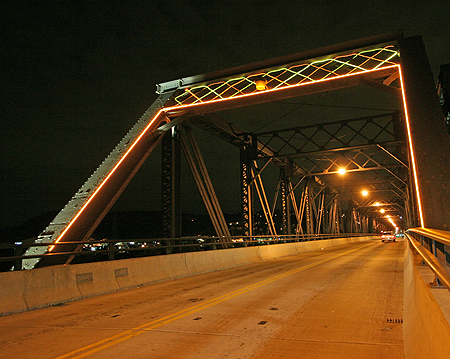
Governor Edward G. Rendell, accompanied by Mayor Luke Ravenstahl, activated the lighting of the portals of the Hot Metal Bridge, as it is commonly called today, at 8:15 p.m., Thursday, June 12, 2008.
The ceremony took place at the Steelworkers’ Monument on the South Bank of the Monongahela River. This was the third bridge decoratively lighted under the auspices of Pittsburgh History & Landmarks Foundation (Landmarks). The first was the Smithfield Street Bridge and the second was the Roberto Clemente Bridge.
Actually, the portal lighting decorates the Main Bridge (Monongahela Connecting Railroad Bridge), constructed in 1904 and opened to motor vehicles in 2000. The Hot Metal Bridge of 1900 (opened to bicycles and pedestrians in 2007) replaced the original Hot Metal Bridge of 1887. With the opening of Hot Metal Street in South Side Works, the name “Hot Metal Bridge” is now commonly used to refer to the historic bridge pair that is built on a shared set of piers.
Historically, hot metal––iron just smelted in a blast furnace and still close to 3,000 degrees Fahrenheit—was transported in ladle cars from the blast furnaces on the north shore of Jones & Laughlin’s Pittsburgh Works across the Hot Metal Bridge of 1900 to the Bessemer converters and open-hearth furnaces of the South Side Plant. The Main Bridge of 1904 served the general purposes of the Monongahela Connecting Railroad, including the transportation of steel ingots and slabs.
The bridge lighting is LED tubular lighting in orange, red, and yellow, suggesting the colors of the hot metal and steel slabs that were once transported across the bridges.
Grenald Waldron Associates of Philadelphia designed the lighting for the bridge as they did for the Roberto Clemente Bridge. Courtney Sarge was the principal designer.
The Governor said, “Grenald has done excellent work once again, we are delighted to see Landmarks utilizing Pennsylvania designers and Pittsburgh contractors for the work that they do with bridge lighting.”
Funding for the project came primarily from a grant from the Department of Community and Economic Development at the Governor’s request. That grant totaled $125,000. Design of the lighting was financed by grants from the Soffer Corporation, the International Brotherhood of Electrical Workers, Wellington Power, and Landmarks totaling $12,500. Landmarks also underwrote an additional $15,000 of costs for the project, bringing the total to approximately $150,000.
Mayor Ravenstahl pointed out, “This is another fine public-private accomplishment in our goal to make Pittsburgh a uniquely attractive city by capitalizing on our historic assets. We thank the Governor and Landmarks and our city team for bringing about this excellent result.
Mark Bibro, Chair of Landmarks, said, “We are grateful that we have a governor who understands the significance of lighting these great engineering monuments to promote their continued use and increase tourism. We are the ‘City of Bridges,’ with 446 bridges (based on the most recent count) within the City limits, and hundreds more throughout Allegheny County. We must continue this lighting program.
Founded in 1964, the Pittsburgh History & Landmarks Foundation works to identify and save architectural landmarks; revitalize historic neighborhoods; and instill community pride. Visit www.phlf.org or call 412-471-5808 for information about preservation services, educational programs, and membership benefits.
# # #


